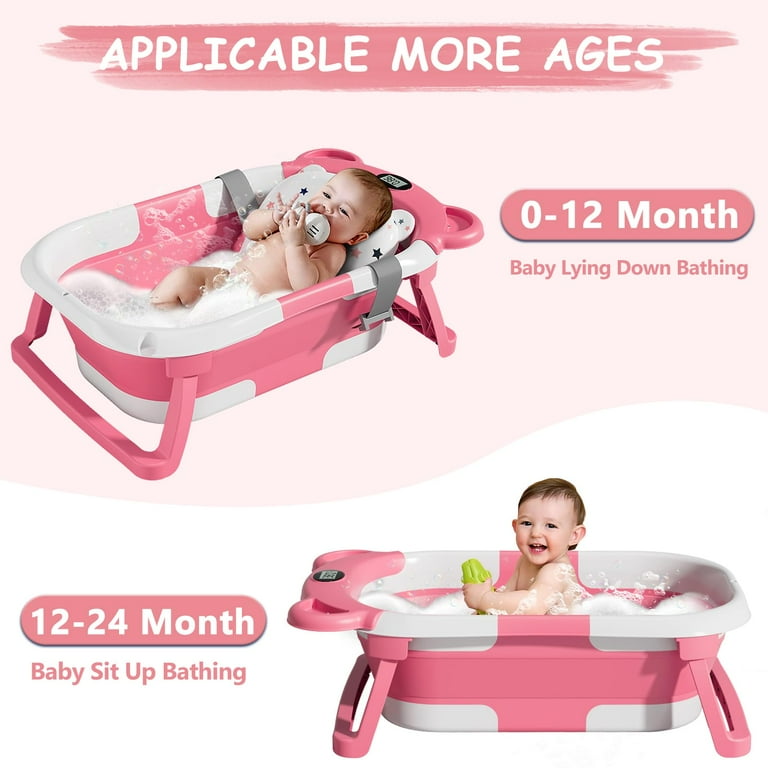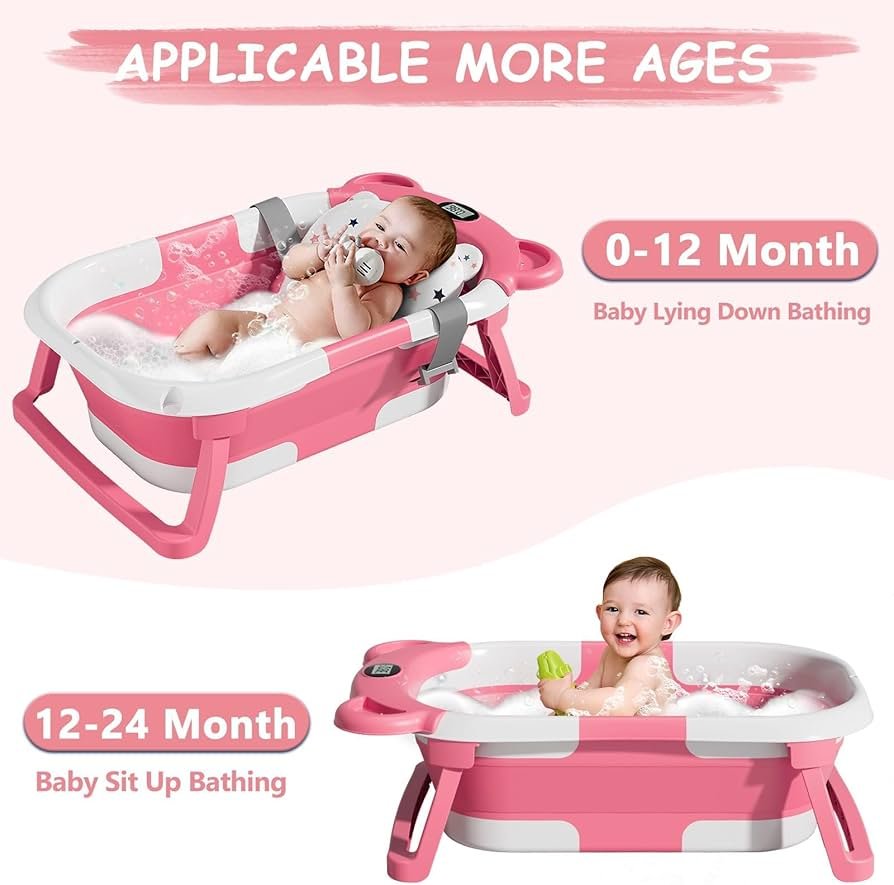The perfect age for a baby to sit in the bath is around six months. At this age, most babies can sit up with support, making bath time safer.
It’s an exciting milestone for parents and babies alike. Bath time can be fun, but safety is important. Babies grow fast, and their abilities change quickly. Sitting up independently marks a significant step in your baby’s development. It allows them to explore their world in new ways, including during bath time.
Understanding when a baby can sit in the bath helps ensure their safety and comfort. Parents often wonder when it’s safe to move from using baby baths to the big tub. Knowing the right age can help in creating a joyful and secure bath experience for your baby.
Introduction To Baby Bathing
Babies can safely sit in the bath around six months old. This is when they can sit without support. Always supervise closely to ensure their safety.
When you first hold your baby in your arms, every little thing feels monumental. Bathing your baby is one of those moments that’s both exciting and nerve-wracking. You want everything to be perfect, ensuring your little one is comfortable and safe. As you prepare for this new experience, understanding the right age for your baby to sit in the bath can make the process easier and more enjoyable. It’s not just about cleanliness; it’s about creating a bond and nurturing your child’s growth.Importance Of Bathing Safety
Safety during bath time is a top priority. Babies are incredibly delicate, and the water can be slippery. You should always hold onto your baby, even if they seem steady. Keep the water temperature warm, not hot, and test it with your elbow before placing your child in the bath.Have you ever thought about what could happen if you turn your back for just a second? A slip can occur in an instant, making constant supervision crucial. Using a non-slip mat can help keep your baby secure, but never rely solely on bath accessories.Parental Considerations
Choosing the right time for your baby to sit up in the bath involves understanding their physical development. Typically, babies can sit independently between six to eight months. Before this stage, you can use a supportive seat to aid their posture.Consider your comfort as well. Bathing a squirmy baby can be challenging, but with the right setup, it can be more enjoyable for both of you. Use a baby bath seat that attaches securely to the tub. This can give your arms a much-needed break while ensuring your baby stays safe.What is your approach when your baby splashes water everywhere? Embrace it! It’s a sign they’re enjoying themselves and exploring their surroundings. Bath time is not just about washing; it’s about encouraging sensory experiences and laughter.Creating a safe, enjoyable bath routine takes time, but it’s a rewarding part of parenting. Your careful attention ensures your baby’s well-being and happiness, making every splash a cherished memory.
Credit: www.instagram.com
Developmental Milestones
Babies grow rapidly in their first year. Parents eagerly watch each new skill. One key milestone is sitting up. This shows growing strength and coordination. Understanding these milestones helps ensure a baby’s safety. Especially during bath time.
Physical Readiness Indicators
Physical readiness is crucial for a baby to sit in the bath. Babies need strong neck and back muscles. These muscles help them sit without support. Most babies achieve this between 4 to 7 months. It’s important to look for signs of stability. Babies should sit steadily on the floor. Bath time requires more balance due to slippery surfaces.
Signs Of Sitting Readiness
Several signs show a baby is ready to sit. Babies start with head control. They can hold their head steady without wobbling. This usually happens around 3 to 4 months. Next, they show interest in sitting. Babies may try to pull themselves up. They enjoy sitting with support. This might occur between 5 to 6 months.
Another sign is reaching for toys. Babies use their arms to balance. They reach and grab objects while sitting. This shows improved hand-eye coordination. The baby should also be able to roll over. Rolling indicates developing core strength. All these signs suggest readiness for sitting in the bath.
Recommended Age Range
Bath time can be a fun experience for babies. Parents often wonder about the perfect age for a baby to sit in the bath. Understanding the recommended age range helps ensure safety and comfort. Knowing the right time can make bath time enjoyable for both parent and child.
Typical Age For Sitting
Babies usually start sitting up between 6 to 8 months. At this age, they develop stronger muscles and balance. Some may sit earlier, while others take a bit longer. Observing your baby’s growth is key.
Factors Influencing Readiness
Several factors affect a baby’s readiness to sit in the bath. Physical development plays a significant role. Babies need strong back and neck muscles for support. Emotional readiness is important too. Some babies feel more comfortable and confident sitting in water. Parents should consider their child’s temperament.
Safety is another crucial factor. Ensure your baby can maintain a sitting position without support. Never leave them unattended in the bath. Supervision is essential to prevent accidents.
Some babies may enjoy the water earlier than others. Each child is unique. Understanding these factors helps determine the right time for your baby to sit in the bath.

Credit: www.walmart.com
Safety Precautions
Ensuring your baby’s safety during bath time is crucial. As babies grow, they become more curious and active. This curiosity can lead to unexpected dangers in the bath. Understanding safety precautions helps prevent accidents. It’s important to create a safe bathing environment. Here’s what you need to know.
Supervision Necessity
Never leave your baby alone in the bath. Always keep an eye on them. Constant supervision is essential. Babies can slip or tip over quickly. Being present ensures immediate response. Use a comfortable seat for your baby. It provides stability and support.
Slip Prevention Tips
Slippery surfaces are a common bath hazard. Use non-slip mats in the tub. These mats offer grip and prevent falls. Check the water temperature before bathing. Lukewarm water is best for safety. Ensure soap is applied carefully. Excess soap increases slipperiness. Keep all bath items within reach. This avoids unnecessary movements that might cause slips.
Bathing Equipment
When your little one is ready to sit in the bath, choosing the right equipment is key. Proper bathing tools ensure safety and make bath time fun. They help maintain the right water temperature and support your baby’s delicate body.
Choosing The Right Bathtub
Selecting a suitable bathtub for your baby is crucial. Look for a tub with non-slip surfaces. This prevents accidents and keeps your baby secure. Some tubs come with built-in temperature indicators. These help maintain the perfect water warmth. Also, choose a tub that fits in your bathroom space comfortably. Portable tubs are great for small spaces or travel. They are lightweight and easy to store.
Bath Support Accessories
Bath supports provide extra safety for your baby. These accessories help your baby sit upright securely. Many support seats have adjustable straps. These keep your baby snug and prevent slipping. Foam inserts are another option. They offer a soft and comfortable bathing experience. Choose supports made of quick-drying materials. This prevents mildew and keeps the bath area hygienic. Make sure any support you use fits the bathtub size. Proper fit ensures maximum safety and comfort.

Credit: www.amazon.com
Creating A Comfortable Environment
Creating a comfortable environment is essential for your baby’s bath time. At the perfect age, sitting in the bath can be a delightful experience. You want your baby to feel safe and secure. This section will guide you on how to make bath time enjoyable. From water temperature to a soothing routine, every detail counts.
Water Temperature Guidelines
Water temperature plays a crucial role in your baby’s comfort. Ensure the water is warm, not hot. The ideal temperature is around 37 degrees Celsius. Use a bath thermometer for accuracy. Always test the water with your wrist or elbow. This ensures it’s gentle on your baby’s delicate skin.
Soothing Bath Time Routine
A soothing routine helps your baby relax in the bath. Start with a gentle voice and calm demeanor. Sing a soft song or play gentle music. Use a soft washcloth to gently wash their body. Introduce toys that float and are safe for their age. This keeps them entertained and happy. A routine creates consistency and comfort for your baby.
Common Concerns And Solutions
Parents often worry about their baby’s first bath. Concerns arise with water safety and comfort. Understanding common issues helps ease worries. Let’s explore some common concerns and their solutions.
Addressing Fear Of Water
Many babies fear water initially. The splashes might startle them. A gentle introduction can help. Use a small amount of water in the tub. Let your baby play with it. Gradually increase the water level. Show them it’s safe and fun.
Bath toys can be helpful too. They distract and entertain. Singing or talking softly reassures your baby. Create a calm atmosphere. This builds their confidence in water.
Dealing With Fidgety Babies
Fidgety babies can make bath time challenging. They move and wiggle constantly. Secure seating is crucial. Consider using a baby bath seat. It provides support and stability.
Engage them with toys or splashy games. Keep the bath time short and enjoyable. This prevents restlessness. Praise and encourage your baby. Positive reinforcement works wonders.
Frequently Asked Questions
When To Let Baby Sit In Bathtub?
Babies can sit in the bathtub once they can independently sit, usually around 6 months. Always supervise closely. Ensure water level is low to prevent accidents. Use a non-slip mat for safety. Keep bath time short, around 10 minutes, to prevent skin irritation.
Always test water temperature before bathing.
At What Age Can A Baby Sit In The Bath Without A Seat?
Babies can usually sit in the bath without a seat around 6 to 8 months old. Always supervise closely. Ensure they can sit steadily and never leave them unattended. Each baby develops at their own pace, so adjust based on your child’s abilities and comfort.
When Should A Baby Be First Bathed?
A baby should be first bathed after the umbilical cord stump falls off. This usually happens within the first few weeks. Until then, give sponge baths to keep the baby clean. Always ensure the bathing area is warm and safe for the newborn.
When Can You Submerge Baby In Bath?
Submerge your baby in a bath once the umbilical cord stump falls off, usually around 1-2 weeks. Ensure the water is shallow and warm. Always supervise closely to keep your baby safe. Use gentle products suitable for delicate skin.
What Is The Ideal Age For A Baby To Sit In The Bath?
Most babies can sit in the bath around 6 months old. They need strong neck and back muscles.
Conclusion
Understanding your baby’s bath readiness is crucial. Each baby develops uniquely. Generally, babies sit in the bath around six months. Monitor their strength and balance. Safety is the top priority. Always supervise bath time closely. Use a bath seat for support if needed.
Make the experience joyful and safe. Listen to your baby’s cues. Trust your instincts as a parent. Every bath is a bonding opportunity. Cherish these special moments together. Enjoy nurturing and caring for your little one. Happy bathing!




